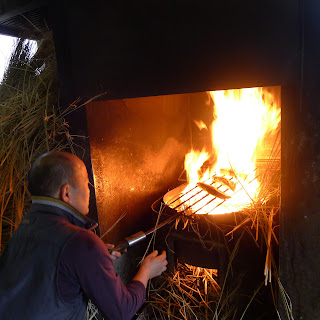Aji Tataki, pounded skipjack on the island of Shikoku
Whilst visiting Japan, researching sashimi for my latest book Raw and Rare, I was taken to Taisho, a small town, covered market in Kochi in Southern Shikoku by my friends Chikaku and Koichi. The goal was to meet Mr Tanaka and to learn about Tataki, Kochi’s pounded and seared skipjack tuna speciality, the crème de la crème of the sashimi feast. Mr Tanaka travels the world to show off his skills but today he is busy in his fish shop at home.
|
Taisho has all the trappings of the famous food markets in Kyoto and Tokyo but is of a manageable size to fulfil the needs of a small local population. A pitched timber roof hung with brightly coloured banners and hundreds of red and blue carp kites celebrating “Boys’ Day”, provides shelter from the driving rain and the two facing rows of small shop units selling food stuffs. cloths and household items. We run the gauntlet of the stalls, coming to a halt next to the fish.
Mr Tanaka steps forward; he presents the classic image of the Japanese fishmonger from an ancient wood-block print. He wears a long, dark grey, apron wrapped tightly around his slight form and a matching, close fitting gilet. His bald head is uncovered save for the shaved grey stubble at ear height. Introductions are made, we smile and bow to one another.
The Bonito Katsuo
He picks up two bulging but taught silver torpedo shaped bonito by their slender tails, (they are about fifty to seventy centimetres long, with a girth of possibly equal proportion) and slings them onto a cutting bench. He sets to work, slicing off the heads at a sharp angle and filleting the dark red, translucent flesh inside. He slices along the spine cutting the bonito in half and then cuts these again, creating four long triangular shaped fillets. He lies one of the fillets on one tray and the other three are thrown casually into another. He repeats the process with the other bonito and explains that three fillets are harder and lumpy and are therefore destined for the searing treatment. The remaining fillet is perfectly uniform and soft in texture; this will be used for sashimi. He explains that both touch and smell indicate the quality of each piece of fish. Sashimi quality fish is of the highest grade.
We follow Mr Tanaka, behind the shop to where there is a pile of rice straw and a kind of brazier. The straw is piled high and ignited, sending wild flames into the air. The fillets of bonito are salted generously and then pounded and laid across a giant fork-like griddle with a long wooden handle, which is introduced to the flames. The griddle is moved moved around in the fire for about 4 minutes, then pulled out of the fire and rested on a table top. The bonito is turned once on the “fork” and returned to the flames just for a minute or so.
Back in the fish shop we watch him slice the seared bonito and then follow him to his busy little eatery (the equivalent of a market caff) opposite his shop. Mrs Tanaka sits us down and makes us welcome. Here, squeezed in around a small table, we feast on the sublime tuna accompanied by spring onion, shredded daikon and ponzu dipping sauce. We are surrounded by locals, all enjoying our lunch.

























